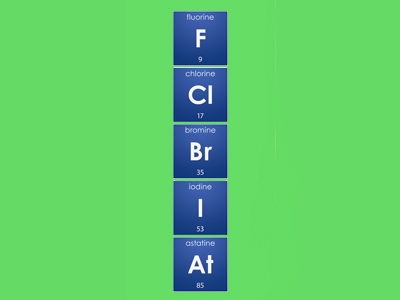In high school Chemistry students must have a good knowledge of the periodic table. Most UK exam boards still follow the convention that the number of electrons in the outer shell = number of group. Since most schools teach to that convention, we use it in our quizzes. If you study chemistry to higher levels, you will find that this is no longer the case other than for groups 1 and 2.
In this quiz we look at the group 7 elements - the halogens.
Halogens is a combination of ancient Greek words that mean 'salt formers'. This refers to the fact that the group 7 elements will produce salts directly with metals. The combination of sodium and chlorine for example produces sodium chloride - common salt.
Naming the salts formed from the halogens is fairly straightforward: remove the ending -ine and replace it with the ending -ide. So if the halogen iodine reacts with the metal potassium, the salt formed will be potassium iodide.
On the periodic table, the halogens are the last but one group (vertical column), right next to the noble gasses. The group number is 7 which indicates that halogen atoms contain seven electrons in the outer shell (energy level). In order to achieve stability and have the same structure as the nearest noble gas, these atoms gain a single electron (rather than losing seven electrons which would take much more energy).
Because they gain an electron during chemical reactions with metals, the halogens form negative ions with a single negative charge. Since they are non-metals, they can also share electrons with other non-metals to form molecules. This also allows them to achieve a full outer shell (energy level) of electrons. Under normal conditions, the halogens exist as diatomic molecules.
The physical and chemical properties of group 7 elements in the periodic table show several characteristic patterns. The melting and boiling points increase as you descend the group; they are more highly colored as you go down the group; they form acidic compounds with hydrogen and so on. They become less reactive as you go down the group because the outer electrons are progressively further away from the nucleus so it is harder for the nucleus to attract in the extra electron required for stability.
One of the main pieces of chemistry that you need to know for the halogens is their displacement reactions. These reactions are always studied in aqueous solution. Add iodine to a solution of a metal chloride and no reaction will take place. But if you add chlorine to a solution of potassium iodide, iodine is displaced. You need to be able to interpret the results of these reactions as well as recognize (and possibly write) their equations. But if you know the simple rule that a more reactive halogen will displace a less reactive one from its compounds plus the characteristic colors of the group 7 elements, you should be able to work out what is happening. The examiners may give you a set of results such as solution A is colorless, when solution B was added, an orange color was observed. You could then be asked to explain what is happening, suggest what solution A and B were, choose the correct equation or even write a word or symbol equation.








